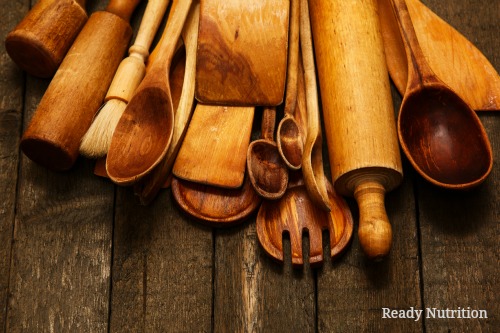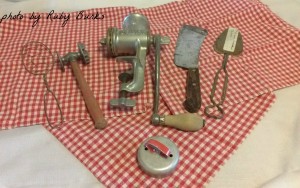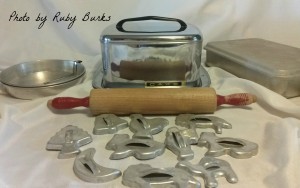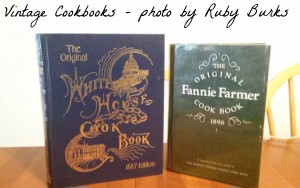
I love my KitchenAide stand mixer and my multi-functional, motorized food processor, but in past generations many of these tools relied on elbow grease instead of electricity, and although you can find modern versions of these tools today, I prefer the vintage versions. The vintage versions of these tools were made in the USA, built to last, and geared towards American practicality.
Cookbooks
In the past, recipes in cookbooks relied on readily available ingredients that were usually locally sourced to create delicious, filling, and nutritious meals. Very little was wasted, including leftovers.
Two of my favorite cookbooks are:
- The Original White House Cookbook 1887 Edition (the 1999 edition was published by Ottenheimer Publishers, Inc)
- The Original Fannie Farmer Cookbook 1896 (a facsimile of the first edition of The Boston Cooking-School Cookbook by Fannie Merritt Farmer, published by Crown Publishers, Inc).
Note: Care should always be taken when using old recipes that they comply with modern food safety standards.
It’s recently become popular (again) to make meat stock. There are many recipes on the Internet for “bone broth” and the like, but none have the same elegance combined with frugality as the recipe in The Original White House Cookbook:
“Consommé, or Stock, forms the basis of all meat soups, and also of all principle sauces. It is, therefore, essential to the success of these culinary operations to know the most complete and economical method of extracting from a certain quantity of meat the best possible stock or broth. Fresh uncooked beef makes the best stock, with the addition of cracked bones, as the glutinous matter contained in them renders it important that they should be boiled with the meat, which adds to the strength and thickness of the soup.”
The recipe given for making “Stock” is both economical and delicious:
“Six pounds of shin of beef, or six pounds of knuckle of veal; any bones, trimmings of poultry, or fresh meat; one-quarter pound of lean bacon or ham, two ounces of butter, two large onions, each stuck with cloves; one turnip, three carrots, one head of celery, two ounces of salt, one-half teaspoon of whole pepper, one large blade of mace, one bunch of savory herbs except sage, four quarts and one half-pint of cold water.
Cut up the meat and bacon, or ham, into pieces about three inches square; break the bones into small pieces, rub the butter on the bottom of the stewpan; put in one half-pint of water, the broken bones, then meat and all other ingredients. Cover the stewpan, and place it on a sharp fire, occasionally stirring it contents. When the bottom of the pan becomes covered in a pale, jelly-like substance, add the four quarts of cold water, and simmer very gently for five or six hours. As we have said before, do not let it boil quickly. When nearly cooked, throw in a tablespoon of salt to assist the scum to rise. Remove every particle of scum whilst it is doing, and strain through a *fine hair sieve; when cool remove all grease.”
Author’s note: a “fine hair sieve” is not made of hair. It’s made of fine wire like this one here.
The section titled “To Preserve Eggs” is an example of being cautious about modern food safety guidelines. Here in the USA, store-bought eggs are washed before being sold and are kept refrigerated, however, this wasn’t always the case and is still not how it’s done in some European countries. So, use your best judgment before deciding to follow this advice:
“There are several recipes for preserving eggs, and we give first one which we know to be effectual, keeping them fresh from August until Spring. Take a piece of quick-lime as large as a good-sized lemon, and two tea cupfuls of salt; put it into a large vessel and slack it with a gallon of boiling water. It will boil and bubble until thick as cream; when it is cold, pour off the top, which will be perfectly clear. Drain off this liquor, and pour it over your eggs; see that the liquor more than covers them. A stone jar is most convenient; – one that holds about six quarts.
Another manner of preserving eggs is to pack them in a jar with layers of salt between, the large end downward, with a thick layer o salt at the top; cover tightly, and set in a cool place.
Some put them in a wire basket or a piece of mosquito net, and dip them in boiling water half a minute; then pack in saw-dust. Still another manner is to dissolve a cheap article of gum Arabic, about as thin as mucilage, and brush over each egg with it; then pack in powdered charcoal; set in a cool, dark place. Eggs can be kept for some time by smearing the shells with butter or lard; then packed in plenty of bran or sawdust, the eggs not allowed to touch one another; or coat the eggs with melted paraffine.”
Utensils
 Nothing beats good hand tools, especially if they come passed down from previous cooks and with fond memories.
Nothing beats good hand tools, especially if they come passed down from previous cooks and with fond memories.
I found some of these tools in second-hand stores, but the majority came from the women in my family. From left to right…
- Mawmaw Burks’ deep fry spatula – I don’t know if this was store-bought or if it was handmade, but I love the ingenuity of using chicken wire to make a kitchen tool.
- My mother’s meat tenderizer- many delicious chicken-fried steaks were made using this meat tenderizer and it’s still useful today to tenderize less expensive cuts of meat prior to cooking.
- A hand crank meat grinder that I picked up at a thrift store for less than $10- I have an attachment for KitchenAide, but for small batches, this works great. Plus, if the power ever goes out or I find myself needing to live without it entirely, this tool will come in handy
- A meat cleaver I picked up at a thrift-store years ago for under $5 – no kitchen should be without a meat cleaver. I use this one regularly (as you can see by the wear) and keep it sharp. Cleavers are great for cutting through joints and reducing the strain on your hands when cutting and wrapping large quantities of meat. A word of caution: be sure to use a thick cutting board when using a cleaver. A cleaver will go right through those flexible, flimsy plastic cutting boards.
- My Great-Grandmother Taylor’s spatula. This is one of the vintage tools in my kitchen I no longer use for fear of breaking it. I labeled it to make sure it wouldn’t get used by anyone else in the household. The handle reads, “Albers Flapjack Flour” on one side of the handle and “Peacock Buckwheat Flour” on the other side. There’s a bottle opener at the end of the handle. There are a few of them available on eBay, but then it wouldn’t be the very one my great-grandmother used.
- Possibly my most prized vintage tool of all- my Grandmother Ham’s biscuit cutter. I was born sickly, as they used to say, and spent a lot of time at Grandmother Ham’s house recuperating. As the fifth child in a family of six kids, it was wonderful to get undivided attention from Grandmother. While recovering from measles, the only thing I would eat was her rolled biscuits with lots of butter and honey. And ice cream. Lots and lots of ice cream. There’s a center piece in the cutter that can be removed to cut biscuits, or when left in, it cuts a hole for donuts- deep fried and still warm, sprinkled with granulated sugar. Mothers love their children, but grandmothers spoil them. And that’s a good thing.
Cakes and Cookies
 My children are all grown now (bring on the grandbabies!), but when they were young, they each got to choose their favorite birthday cake made from scratch.
My children are all grown now (bring on the grandbabies!), but when they were young, they each got to choose their favorite birthday cake made from scratch.
During the holidays, my kitchen was filled with children and cookies. My children, their friends from school, and the neighbor’s children were all invited over for a day of decorating sugar cookies. Parents were asked to contribute whatever they could towards the festivities (a bag of flour or sugar, jimmies or other decorations, a pound of butter – whatever they felt like they could afford), and advised to bring their own plate so their children could take their creations home. I had more than a few children show up on Cookie Day without anything to contribute and none were ever turned away.
I don’t know how long this tradition has been going on, but I remember doing it as a child with my own mother. The rolling pin belonged to my mom as did the cookie cutters in the picture above. Over the years I’ve added quite a few more cookie cutters to my collection, but these are the ones I love best. I still occasionally see some of the young adults who were once my children’s friends and to this day they still refer to me as the Cookie Mom. They also mention, half-jokingly, how strict I was when that many children were fighting over plastic bowls of jimmies. I like how one of them, now a young man, put it recently: “There was no doubt we had to mind our manners at your table…and you gave us cookies.”
I like to think Grandmother Ham would have been proud of me.
This article was originally published at Ready Nutrition™ on November 19th, 2015







